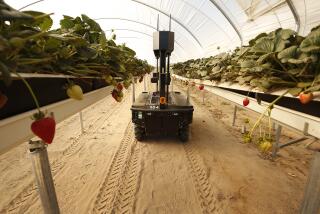Summit Addresses Future of Farms
Ventura County’s $1.4-billion agricultural industry is healthy now, but its viability is threatened by soaring land costs, excessive regulation and global competition, area farmers said Thursday.
They were among more than 400 local growers, business representatives and civic leaders attending an agricultural summit in Oxnard on Thursday. The topic: how best to sustain the county’s fragile industry for decades to come.
If residents wish to maintain the verdant farm fields and open spaces that set Ventura County apart from its urban neighbors, they must demand that policymakers make it easier for farmers to operate, said one farmer after another.
“You all want agriculture to stay here, but it’s not getting a lot more fun,” said Link Leavens, a longtime grower.
Leavens’ Ventura fields are surrounded by residential development, including a school and a church. It has become increasingly difficult to use pesticides and carry out other farm operations due to neighborhood complaints, Leavens said.
Gary and Joanne Seaton of Simi Valley, who farm 30 acres of avocados, said they have had to contend with neighbors trying to stop them from planting crops on hillsides.
The couple said they came to the forum because they love farming but worry about their ability to continue.
“This is happening just in time,” Joanne Seaton said of the conference. “If we waited another five, 10 years, agriculture would be gone.”
Owners of small organic farms urged the creation of local networks to distribute their produce. As it stands now, they cannot compete with grocery chains that scour the globe for the cheapest fruits and vegetables.
Other speakers suggested forming a regional governing board to steer long-term planning, giving farmers new property tax breaks and forming a cooperative marketing team to sell locally-grown produce.
But there are other, larger roadblocks that will take a great deal of creativity and energy to solve, said Hugh Ralston of the Ventura County Civic Alliance, one of the forum’s organizers.
Among them are the nation’s immigration polices, which make it difficult to find cheap labor; tax policies that encourage big-box stores such as Wal-Mart; and competition from cheap producers in Mexico, China and South America.
“It’s not going to be hard -- it’s going to be very hard,” Ralston said. “But the default position is for the market forces to take control.”
The group also heard from advocates of a statewide initiative, the Vivid Picture Project, to change the farming and food distribution system to one that emphasizes and rewards locally-produced foods and farming.
“It’s really clear to me that Ventura County is ripe to take the next step,” said Gail Feenstra, a Vivid Picture Project analyst based at UC Davis.
More to Read
Sign up for Essential California
The most important California stories and recommendations in your inbox every morning.
You may occasionally receive promotional content from the Los Angeles Times.











